- 1谈谈程序员面试之刷题
- 2深度解析MBTI:了解其发展历史与演变过程(包含开源免费的API接口)
- 3自定义表单元素组件内容变化触发ElForm重新校验
- 4阿里巴巴一面 :十道经典面试题解析_阿里面试题
- 5聊天机器人是人工智能吗?探索人机交互的未来
- 6Stable Diffusion 秋叶整合包v4.7 :解压即用,快速入门AI绘画_stable diffusion秋叶整合包
- 7FPGA认识-什么是FPGA(1)_fpga是什么
- 8美赛、国赛数模竞赛最后一层遮羞布——查重问题_美赛被判dq会公示嘛
- 9想进BAT的 iOS程序员,看完这个你还觉得Offer难拿吗?_非程序员进bat难吗
- 10霸榜GitHub Top 500的中国开源项目
NLP_知识图谱_三元组实战_知识图谱 根据类型 生成图谱三元组
赞
踩
三元组含义
知识图谱的三元组,指的是 <subject, predicate/relation, object> 。同学们会发现很多人类的知识都可以用这样的三元组来表示。例如:<中国,首都,北京>,<美国,总统,特朗普> 等等。
所有图谱中的数据都是由三元组构成
工业场景通常把三元组存储在图数据库中如neo4j,图数据的优势在于能快捷查询数据。
学术界会采用RDF的格式存储数据,RDF的优点在于易于共享数据。
如何构建知识图谱
构建知识图谱通常有两种数据源
1、结构化数据,存储在关系型数据库中的数据,通过定义好图谱的schema,然后按照schema的格式,把关系型数据转化为图数据。
2、非结构化数据,通常又包括了纯文本形式和基于表格的形式,通常采用模板或者模型的方式,从文本中抽取出三元组再入库。
在实际的工业场景中,数据往往是最难处理的,这和比赛情况完全不同,比赛的数据较为干净、公整。但是在工业场景中,会出现难以构建schema、数据量极少、无标注数据等情况。
所以,对于不同的情况我们应该采用不同的处理方式,而不是一味的去采用模型处理。例如表格数据,其实采用规则的方式效果会很不错。
模型的整体结构
该模型只是一个baseline,还有很多的优化空间,大家可以根据自己的理解与想法,去迭代升级模型。
模型的整体结构如左图所示,输入是一段文本信息,经过encoder层进行编码,提取出头实体,再对头实体编码并复用文本编码,接下来用了个小trick,同时预测尾实体与关系,当然你也可以分开先预测尾实体,再预测关系。
对于实体的预测,我们可以使用BIO的方式,这里我们换一种思路,半指针半标注。
接下里我们看个具体的例子

句子案例:周星驰主演了喜剧之王,周星驰还演了其它的电影…
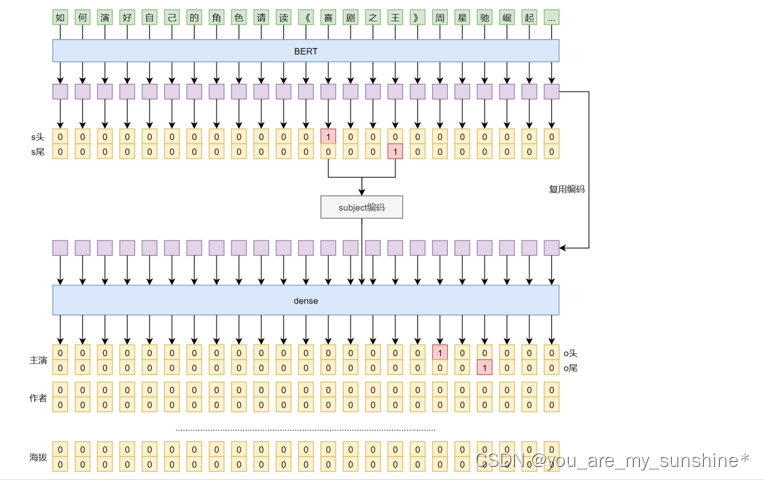
基于transformers框架的三元组抽取baseline
how to use
下载预训练模型,放到bert目录下,下载训练数据放到data目录下
安装transformers,pip install transformers
执行train.py文件
预训练模型下载地址
bert https://huggingface.co/bert-base-chinese/tree/main
roberta https://huggingface.co/hfl/chinese-roberta-wwm-ext/tree/main
训练数据下载地址
链接:https://pan.baidu.com/s/1rNfJ88OD40r26RR0Lg6Geg 提取码:a9ph
结构图
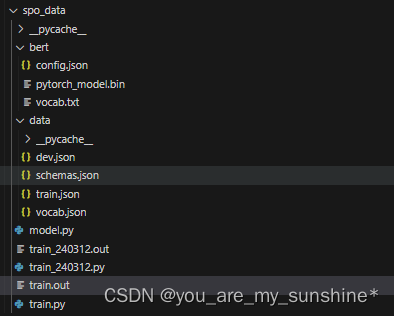
代码及数据
bert
config.json
{ "architectures": [ "BertForMaskedLM" ], "attention_probs_dropout_prob": 0.1, "directionality": "bidi", "hidden_act": "gelu", "hidden_dropout_prob": 0.1, "hidden_size": 768, "initializer_range": 0.02, "intermediate_size": 3072, "layer_norm_eps": 1e-12, "max_position_embeddings": 512, "model_type": "bert", "num_attention_heads": 12, "num_hidden_layers": 12, "output_past": true, "pad_token_id": 0, "pooler_fc_size": 768, "pooler_num_attention_heads": 12, "pooler_num_fc_layers": 3, "pooler_size_per_head": 128, "pooler_type": "first_token_transform", "type_vocab_size": 2, "vocab_size": 21128 }
- 1
- 2
- 3
- 4
- 5
- 6
- 7
- 8
- 9
- 10
- 11
- 12
- 13
- 14
- 15
- 16
- 17
- 18
- 19
- 20
- 21
- 22
- 23
- 24
- 25
- 26
- 27
vocab.txt
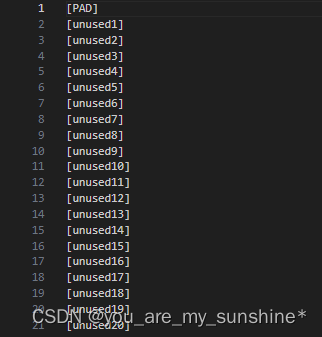
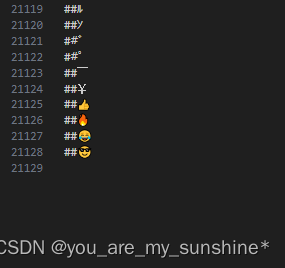
data
dev.json
[ { "text": "查尔斯·阿兰基斯(Charles Aránguiz),1989年4月17日出生于智利圣地亚哥,智利职业足球运动员,司职中场,效力于德国足球甲级联赛勒沃库森足球俱乐部", "spo_list": [ [ "查尔斯·阿兰基斯", "出生地", "圣地亚哥" ], [ "查尔斯·阿兰基斯", "出生日期", "1989年4月17日" ] ] }, ...... ]
- 1
- 2
- 3
- 4
- 5
- 6
- 7
- 8
- 9
- 10
- 11
- 12
- 13
- 14
- 15
- 16
- 17
- 18
schemas.json
[ { "0": "所属专辑", "1": "出品公司", "2": "作曲", "3": "总部地点", "4": "目", "5": "制片人", "6": "导演", "7": "成立日期", "8": "出生日期", "9": "嘉宾", "10": "专业代码", "11": "所在城市", "12": "母亲", "13": "妻子", "14": "编剧", "15": "身高", "16": "出版社", "17": "邮政编码", "18": "主角", "19": "主演", "20": "父亲", "21": "官方语言", "22": "出生地", "23": "改编自", "24": "董事长", "25": "国籍", "26": "海拔", "27": "祖籍", "28": "朝代", "29": "气候", "30": "号", "31": "作词", "32": "面积", "33": "连载网站", "34": "上映时间", "35": "创始人", "36": "丈夫", "37": "作者", "38": "首都", "39": "歌手", "40": "修业年限", "41": "简称", "42": "毕业院校", "43": "主持人", "44": "字", "45": "民族", "46": "注册资本", "47": "人口数量", "48": "占地面积" }, { "所属专辑": 0, "出品公司": 1, "作曲": 2, "总部地点": 3, "目": 4, "制片人": 5, "导演": 6, "成立日期": 7, "出生日期": 8, "嘉宾": 9, "专业代码": 10, "所在城市": 11, "母亲": 12, "妻子": 13, "编剧": 14, "身高": 15, "出版社": 16, "邮政编码": 17, "主角": 18, "主演": 19, "父亲": 20, "官方语言": 21, "出生地": 22, "改编自": 23, "董事长": 24, "国籍": 25, "海拔": 26, "祖籍": 27, "朝代": 28, "气候": 29, "号": 30, "作词": 31, "面积": 32, "连载网站": 33, "上映时间": 34, "创始人": 35, "丈夫": 36, "作者": 37, "首都": 38, "歌手": 39, "修业年限": 40, "简称": 41, "毕业院校": 42, "主持人": 43, "字": 44, "民族": 45, "注册资本": 46, "人口数量": 47, "占地面积": 48 } ]
- 1
- 2
- 3
- 4
- 5
- 6
- 7
- 8
- 9
- 10
- 11
- 12
- 13
- 14
- 15
- 16
- 17
- 18
- 19
- 20
- 21
- 22
- 23
- 24
- 25
- 26
- 27
- 28
- 29
- 30
- 31
- 32
- 33
- 34
- 35
- 36
- 37
- 38
- 39
- 40
- 41
- 42
- 43
- 44
- 45
- 46
- 47
- 48
- 49
- 50
- 51
- 52
- 53
- 54
- 55
- 56
- 57
- 58
- 59
- 60
- 61
- 62
- 63
- 64
- 65
- 66
- 67
- 68
- 69
- 70
- 71
- 72
- 73
- 74
- 75
- 76
- 77
- 78
- 79
- 80
- 81
- 82
- 83
- 84
- 85
- 86
- 87
- 88
- 89
- 90
- 91
- 92
- 93
- 94
- 95
- 96
- 97
- 98
- 99
- 100
- 101
- 102
- 103
- 104
train.json
[
{
"text": "如何演好自己的角色,请读《演员自我修养》《喜剧之王》周星驰崛起于穷困潦倒之中的独门秘笈",
"spo_list": [
[
"喜剧之王",
"主演",
"周星驰"
]
]
},
......
]
- 1
- 2
- 3
- 4
- 5
- 6
- 7
- 8
- 9
- 10
- 11
- 12
- 13
vocab.json
[ { "2": "如", "3": "何", ...... "7028": "鸏", "7029": "溞" }, { "如": 2, "何": 3, ...... "鸏": 7028, "溞": 7029 } ]
- 1
- 2
- 3
- 4
- 5
- 6
- 7
- 8
- 9
- 10
- 11
- 12
- 13
- 14
- 15
- 16
与bert跟data同个目录
model.py
from transformers import BertModel, BertPreTrainedModel import torch.nn as nn import torch class SubjectModel(BertPreTrainedModel): def __init__(self, config): super().__init__(config) self.bert = BertModel(config) self.dense = nn.Linear(config.hidden_size, 2) def forward(self, input_ids, attention_mask=None): output = self.bert(input_ids, attention_mask=attention_mask) subject_out = self.dense(output[0]) subject_out = torch.sigmoid(subject_out) return output[0], subject_out class ObjectModel(nn.Module): def __init__(self, subject_model): super().__init__() self.encoder = subject_model self.dense_subject_position = nn.Linear(2, 768) self.dense_object = nn.Linear(768, 49 * 2) def forward(self, input_ids, subject_position, attention_mask=None): output, subject_out = self.encoder(input_ids, attention_mask) subject_position = self.dense_subject_position(subject_position).unsqueeze(1) object_out = output + subject_position # [bs, 768] -> [bs, 98] object_out = self.dense_object(object_out) # [bs, 98] -> [bs, 49, 2] object_out = torch.reshape(object_out, (object_out.shape[0], object_out.shape[1], 49, 2)) object_out = torch.sigmoid(object_out) object_out = torch.pow(object_out, 4) return subject_out, object_out
- 1
- 2
- 3
- 4
- 5
- 6
- 7
- 8
- 9
- 10
- 11
- 12
- 13
- 14
- 15
- 16
- 17
- 18
- 19
- 20
- 21
- 22
- 23
- 24
- 25
- 26
- 27
- 28
- 29
- 30
- 31
- 32
- 33
- 34
- 35
- 36
- 37
- 38
- 39
- 40
- 41
- 42
- 43
train.py
import json from tqdm import tqdm import os import numpy as np from transformers import BertTokenizer, AdamW, BertTokenizerFast import torch from model import ObjectModel, SubjectModel GPU_NUM = 0 device = torch.device(f'cuda:{GPU_NUM}') if torch.cuda.is_available() else torch.device('cpu') vocab = {} with open('bert/vocab.txt', encoding='utf_8')as file: for l in file.readlines(): vocab[len(vocab)] = l.strip() def load_data(filename): """加载数据 单条格式:{'text': text, 'spo_list': [[s, p, o],[s, p, o]]} """ with open(filename, encoding='utf-8') as f: json_list = json.load(f) return json_list # 加载数据集 train_data = load_data('data/train.json') valid_data = load_data('data/dev.json') tokenizer = BertTokenizerFast.from_pretrained('bert') with open('data/schemas.json', encoding='utf-8') as f: json_list = json.load(f) id2predicate = json_list[0] predicate2id = json_list[1] def search(pattern, sequence): """从sequence中寻找子串pattern 如果找到,返回第一个下标;否则返回-1。 """ n = len(pattern) for i in range(len(sequence)): if sequence[i:i + n] == pattern: return i return -1 def sequence_padding(inputs, length=None, padding=0, mode='post'): """Numpy函数,将序列padding到同一长度 """ if length is None: length = max([len(x) for x in inputs]) pad_width = [(0, 0) for _ in np.shape(inputs[0])] outputs = [] for x in inputs: x = x[:length] if mode == 'post': pad_width[0] = (0, length - len(x)) elif mode == 'pre': pad_width[0] = (length - len(x), 0) else: raise ValueError('"mode" argument must be "post" or "pre".') x = np.pad(x, pad_width, 'constant', constant_values=padding) outputs.append(x) return np.array(outputs) def data_generator(data, batch_size=3): batch_input_ids, batch_attention_mask = [], [] batch_subject_labels, batch_subject_ids, batch_object_labels = [], [], [] texts = [] for i, d in enumerate(data): text = d['text'] texts.append(text) encoding = tokenizer(text=text) input_ids, attention_mask = encoding.input_ids, encoding.attention_mask # 整理三元组 {s: [(o, p)]} spoes = {} for s, p, o in d['spo_list']: # cls x x x sep s_encoding = tokenizer(text=s).input_ids[1:-1] o_encoding = tokenizer(text=o).input_ids[1:-1] # 找对应的s与o的起始位置 s_idx = search(s_encoding, input_ids) o_idx = search(o_encoding, input_ids) p = predicate2id[p] if s_idx != -1 and o_idx != -1: s = (s_idx, s_idx + len(s_encoding) - 1) o = (o_idx, o_idx + len(o_encoding) - 1, p) if s not in spoes: spoes[s] = [] spoes[s].append(o) if spoes: # subject标签 subject_labels = np.zeros((len(input_ids), 2)) for s in spoes: # 注意要+1,因为有cls符号 subject_labels[s[0], 0] = 1 subject_labels[s[1], 1] = 1 # 一个s对应多个o时,随机选一个subject start, end = np.array(list(spoes.keys())).T start = np.random.choice(start) # end = np.random.choice(end[end >= start]) end = end[end >= start][0] subject_ids = (start, end) # 对应的object标签 object_labels = np.zeros((len(input_ids), len(predicate2id), 2)) for o in spoes.get(subject_ids, []): object_labels[o[0], o[2], 0] = 1 object_labels[o[1], o[2], 1] = 1 # 构建batch batch_input_ids.append(input_ids) batch_attention_mask.append(attention_mask) batch_subject_labels.append(subject_labels) batch_subject_ids.append(subject_ids) batch_object_labels.append(object_labels) if len(batch_subject_labels) == batch_size or i == len(data) - 1: batch_input_ids = sequence_padding(batch_input_ids) batch_attention_mask = sequence_padding(batch_attention_mask) batch_subject_labels = sequence_padding(batch_subject_labels) batch_subject_ids = np.array(batch_subject_ids) batch_object_labels = sequence_padding(batch_object_labels) yield [ torch.from_numpy(batch_input_ids).long(), torch.from_numpy(batch_attention_mask).long(), torch.from_numpy(batch_subject_labels), torch.from_numpy(batch_subject_ids), torch.from_numpy(batch_object_labels) ] batch_input_ids, batch_attention_mask = [], [] batch_subject_labels, batch_subject_ids, batch_object_labels = [], [], [] if os.path.exists('graph_model.bin'): print('load model') model = torch.load('graph_model.bin').to(device) subject_model = model.encoder else: subject_model = SubjectModel.from_pretrained('./bert') subject_model.to(device) model = ObjectModel(subject_model) model.to(device) train_loader = data_generator(train_data, batch_size=8) optim = AdamW(model.parameters(), lr=5e-5) loss_func = torch.nn.BCELoss() model.train() class SPO(tuple): """用来存三元组的类 表现跟tuple基本一致,只是重写了 __hash__ 和 __eq__ 方法, 使得在判断两个三元组是否等价时容错性更好。 """ def __init__(self, spo): self.spox = ( spo[0], spo[1], spo[2], ) def __hash__(self): return self.spox.__hash__() def __eq__(self, spo): return self.spox == spo.spox def train_func(): train_loss = 0 pbar = tqdm(train_loader) for step, batch in enumerate(pbar): optim.zero_grad() input_ids = batch[0].to(device) attention_mask = batch[1].to(device) subject_labels = batch[2].to(device) subject_ids = batch[3].to(device) object_labels = batch[4].to(device) subject_out, object_out = model(input_ids, subject_ids.float(), attention_mask) subject_out = subject_out * attention_mask.unsqueeze(-1) object_out = object_out * attention_mask.unsqueeze(-1).unsqueeze(-1) subject_loss = loss_func(subject_out, subject_labels.float()) object_loss = loss_func(object_out, object_labels.float()) # subject_loss = torch.mean(subject_loss, dim=2) # subject_loss = torch.sum(subject_loss * attention_mask) / torch.sum(attention_mask) loss = subject_loss + object_loss train_loss += loss.item() loss.backward() optim.step() pbar.update() pbar.set_description(f'train loss:{loss.item()}') if step % 1000 == 0 and step != 0: torch.save(model, 'graph_model.bin') with torch.no_grad(): # texts = ['如何演好自己的角色,请读《演员自我修养》《喜剧之王》周星驰崛起于穷困潦倒之中的独门秘笈', # '茶树茶网蝽,Stephanitis chinensis Drake,属半翅目网蝽科冠网椿属的一种昆虫', # '爱德华·尼科·埃尔南迪斯(1986-),是一位身高只有70公分哥伦比亚男子,体重10公斤,只比随身行李高一些,2010年获吉尼斯世界纪录正式认证,成为全球当今最矮的成年男人'] X, Y, Z = 1e-10, 1e-10, 1e-10 pbar = tqdm() for data in valid_data[0:100]: spo = [] # for text in texts: text = data['text'] spo_ori = data['spo_list'] en = tokenizer(text=text, return_tensors='pt') _, subject_preds = subject_model(en.input_ids.to(device), en.attention_mask.to(device)) # !!! subject_preds = subject_preds.cpu().data.numpy() start = np.where(subject_preds[0, :, 0] > 0.6)[0] end = np.where(subject_preds[0, :, 1] > 0.5)[0] subjects = [] for i in start: j = end[end >= i] if len(j) > 0: j = j[0] subjects.append((i, j)) # print(subjects) if subjects: for s in subjects: index = en.input_ids.cpu().data.numpy().squeeze(0)[s[0]:s[1] + 1] subject = ''.join([vocab[i] for i in index]) # print(subject) _, object_preds = model(en.input_ids.to(device), torch.from_numpy(np.array([s])).float().to(device), en.attention_mask.to(device)) object_preds = object_preds.cpu().data.numpy() for object_pred in object_preds: start = np.where(object_pred[:, :, 0] > 0.2) end = np.where(object_pred[:, :, 1] > 0.2) for _start, predicate1 in zip(*start): for _end, predicate2 in zip(*end): if _start <= _end and predicate1 == predicate2: index = en.input_ids.cpu().data.numpy().squeeze(0)[_start:_end + 1] object = ''.join([vocab[i] for i in index]) predicate = id2predicate[str(predicate1)] # print(object, '\t', predicate) spo.append([subject, predicate, object]) print(spo) # 预测结果 R = set([SPO(_spo) for _spo in spo]) # 真实结果 T = set([SPO(_spo) for _spo in spo_ori]) # R = set(spo_ori) # T = set(spo) # 交集 X += len(R & T) Y += len(R) Z += len(T) f1, precision, recall = 2 * X / (Y + Z), X / Y, X / Z pbar.update() pbar.set_description( 'f1: %.5f, precision: %.5f, recall: %.5f' % (f1, precision, recall) ) pbar.close() print('f1:', f1, 'precision:', precision, 'recall:', recall) for epoch in range(100): print('************start train************') # 训练 train_func() # min_loss = float('inf') # dev_loss = dev_func() # if min_loss > dev_loss: # min_loss = dev_loss # torch.save(model,'model.p')
- 1
- 2
- 3
- 4
- 5
- 6
- 7
- 8
- 9
- 10
- 11
- 12
- 13
- 14
- 15
- 16
- 17
- 18
- 19
- 20
- 21
- 22
- 23
- 24
- 25
- 26
- 27
- 28
- 29
- 30
- 31
- 32
- 33
- 34
- 35
- 36
- 37
- 38
- 39
- 40
- 41
- 42
- 43
- 44
- 45
- 46
- 47
- 48
- 49
- 50
- 51
- 52
- 53
- 54
- 55
- 56
- 57
- 58
- 59
- 60
- 61
- 62
- 63
- 64
- 65
- 66
- 67
- 68
- 69
- 70
- 71
- 72
- 73
- 74
- 75
- 76
- 77
- 78
- 79
- 80
- 81
- 82
- 83
- 84
- 85
- 86
- 87
- 88
- 89
- 90
- 91
- 92
- 93
- 94
- 95
- 96
- 97
- 98
- 99
- 100
- 101
- 102
- 103
- 104
- 105
- 106
- 107
- 108
- 109
- 110
- 111
- 112
- 113
- 114
- 115
- 116
- 117
- 118
- 119
- 120
- 121
- 122
- 123
- 124
- 125
- 126
- 127
- 128
- 129
- 130
- 131
- 132
- 133
- 134
- 135
- 136
- 137
- 138
- 139
- 140
- 141
- 142
- 143
- 144
- 145
- 146
- 147
- 148
- 149
- 150
- 151
- 152
- 153
- 154
- 155
- 156
- 157
- 158
- 159
- 160
- 161
- 162
- 163
- 164
- 165
- 166
- 167
- 168
- 169
- 170
- 171
- 172
- 173
- 174
- 175
- 176
- 177
- 178
- 179
- 180
- 181
- 182
- 183
- 184
- 185
- 186
- 187
- 188
- 189
- 190
- 191
- 192
- 193
- 194
- 195
- 196
- 197
- 198
- 199
- 200
- 201
- 202
- 203
- 204
- 205
- 206
- 207
- 208
- 209
- 210
- 211
- 212
- 213
- 214
- 215
- 216
- 217
- 218
- 219
- 220
- 221
- 222
- 223
- 224
- 225
- 226
- 227
- 228
- 229
- 230
- 231
- 232
- 233
- 234
- 235
- 236
- 237
- 238
- 239
- 240
- 241
- 242
- 243
- 244
- 245
- 246
- 247
- 248
- 249
- 250
- 251
- 252
- 253
- 254
- 255
- 256
- 257
- 258
- 259
- 260
- 261
- 262
- 263
- 264
- 265
- 266
- 267
- 268
- 269
- 270
- 271
- 272
- 273
- 274
- 275
- 276
- 277
- 278
- 279
- 280
- 281
- 282
- 283
- 284
- 285
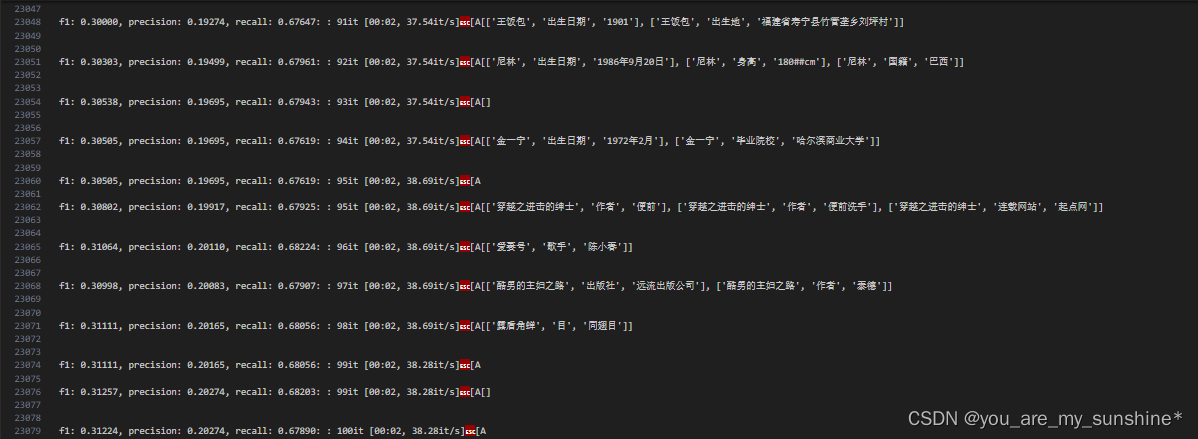
三元组实战小结
模型的整体结构:输入是一段文本信息,经过encoder层进行编码,提取出头实体,再对头实体编码并复用文本编码,接下来用了个小trick,同时预测尾实体与关系。对于实体的预测思路是,半指针半标注。
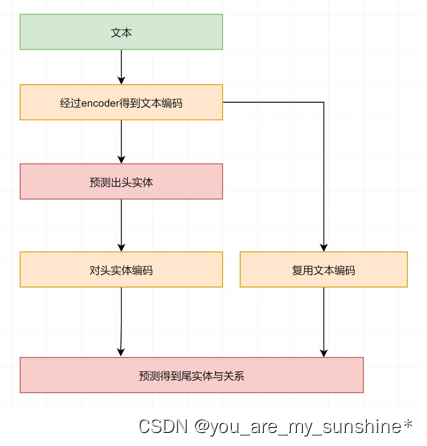
学习的参考资料:
七月在线NLP高级班
代码参考:
https://github.com/terrifyzhao/spo_extract



